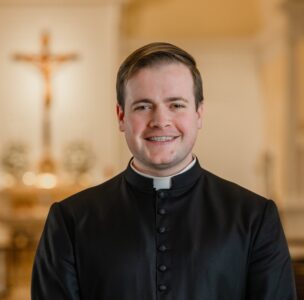Brothers and Sisters in Christ,
As we continue on in John 6, I’d like to encourage you again to read through this chapter of John’s gospel. Following the multiplication of the loaves and fish, and feeding the 5,000, the crowds around Jesus only grow, and he is being sought after all the more. The crowds followed Christ to Capernaum where he begins to teach them the deeper meaning on that miracle. In this exchange the people seek a sign akin to that of the manna given in the desert to the Israelites as they sojourned through the desert to the Promised Land. And while that manna did come down to them from heaven, it only filled their bellies and nourished their body. Christ is revealing to them the greater revelation from God that he wishes to give us the gift of himself as the Bread of Life that nourishes the soul.
Jesus gives mention that the “Son of Man” will provide this food for eternal life, and it is upon him that “God has set his seal.” “Son of Man” is another name or title of Jesus, and this understanding of “God’s seal” is quite important, for all of us have experienced it. It is a symbol very close to that of anointing, indicating a permanent effect. The indelible “mark” or “character” that the Sacraments of Baptism, Confirmation, and Holy Orders leave on the recipient is called a “seal”. Who knows what a soul would physically look like, but we know that those who have been sealed with an indelible mark will be different than those who have not. The seal of the Holy Spirit marks us for Christ, as belonging to him, being strengthened by him, and being committed to his service. Perhaps not the most beautiful analogy, but we the baptized have had our souls branded with the indelible mark of Christ. We are his, the sheep of his flock.
Jesus urges the people to not work for food that perishes but for the food that endures for eternal life. It is a parallel message we hear elsewhere in the Gospels; we do not fear that which kills the body, but that which kills the soul. The fact of our existence is that we are made up of both a body and a soul. We are not entirely one or the other, we are both. Even Aristotle understood this and described it as hylomorphism. Without getting too bogged down in Aristotelian metaphysics, we are made up of body and soul, and it is the fall of Adam and Eve, that original sin that has put them at odds with each other. We are so frequently tempted in the body toward activities or objects that are unhealthy for our soul. That disunity is meant to be overcome through Christ who has come to save us from our sin. He alone feeds body and soul, as he reveals himself as the bread come down from heaven. He is the Bread of Life. With what else would we rather be nourished?
This Gospel scene ends with Jesus declaring himself as the Bread of Life. We will see the response from the crowds. This becomes a point of demarcation for those who accept this message and those who deny it. The rift exists to this day. Praise God for every opportunity we have to worship, adore, and receive the Bread of Life.
Yours in Christ,
Fr. Brendan


